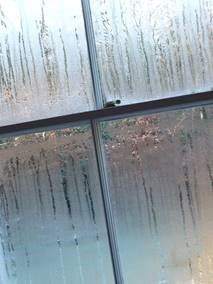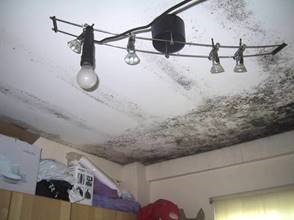Enter your details below and we will call you back as soon as possible:
Winter is here and so begins condensation season
The windows are fogging over and the windowsill is damp – condensation season is well and truly here.
From October to April, temperatures plummet and warm moisture laden air comes into contact with cold surfaces, which results in condensation appearing throughout the interior of buildings.
But what is condensation, and why is it an issue?
What is condensation?

You will most commonly see condensation on your windows or mirrors after running hot water, cooking or operating machinery. The moisture clings to the surface and increases in density until it becomes too heavy for the air to carry. The moisture is then released from the air as droplets of water. These droplets run down the windows and mirrors and collect in pools on the surfaces below.
In Winter, there is a greater difference between the air temperature outdoors and indoors. As the air indoors is warmer and holds more moisture, this leads to more condensation forming when the air collides with colder surfaces.
It isn't just a feature of cold weather though; condensation can occur at any time when the air in your home holds extra moisture. Even activities like walking, talking and breathing can increase the humidity of the air, raising the chances of condensation forming.
Why is it a problem?

If left unchecked, condensation can cause a multitude of problems with damaging consequences for your home, workspace and the health of your family or workforce.
Condensation isn’t restricted to windows; it can also occur on walls, especially external walls of kitchens, bathrooms or warehouses containing machinery. In such spaces where moisture can build up, the water formed from condensation can be absorbed into the plaster on the walls, which become very damp.
This build-up of moisture in walls and even ceilings provides the perfect breeding ground for mould and other forms of bacteria, whose spores can spread to other walls, in cupboards and even on clothes and shoes.
Can it damage a person’s health?
Yes, it can. Medical experts have associated damp and mould with a number of allergic reactions, including sneezing, red eyes and skin rashes, and is known to contribute to diseases such as asthma, bronchitis, sinusitis and tonsillitis.
Babies and children, the elderly and those with existing skin, breathing or immune disorders are more sensitive to the spores than others, and are more likely to grow ill from exposure.
What can I do about it?
As property preservation experts, we can repair damages caused by condensation, rot and a whole host of other property issues. Our air management units will tackle the rising moisture levels in your home or workplace, significantly reducing the amount of condensation produced.
We use a Positive Input Ventilation (or Positive Pressure Ventilation) system to control condensation, which works by drawing clean fresh air into the property from outside at a continuous rate.
This system has some great benefits, including:
- Curing condensation dampness – The system removes humidity from the air, preventing mould growth and controlling dust-mite allergens.
- Improving indoor air quality - Pollutants are removed while outdoor pollutants including traffic fumes, pollen and radon gas are kept to a minimum.
- Meeting regulations - Meets Part F & L of Building Regulations as a low-energy ventilation strategy.
- Providing heat - Thermostatically controlled heater with manual override, to warm the incoming air and help heat the home when required
- Producing low power consumption - As low as 5 watts so it shouldn’t make any difference to your electricity bills. As dry air is easier to heat than moist air, air management units could actually lead to a drop in your heating bills.
- Low maintenance - Filter clean or replacement every 18 months.
- A 5-year warranty - For peace of mind.
What do I do now?
If you’re interested in reducing condensation in your home or workplace, contact us on 01325 728039 or contact your regional office by email. If you have any questions, feel free to tweet us at @BCSPreservation.






















